Brine-Conserving Nanofiltration Water Softener System
a water softener and nanofiltration technology, applied in water/sewage treatment by ion exchange, water treatment parameter control, ion exchangers, etc., can solve the problems of significant water pollution from brine solution discharged from water softeners, serious long-term environmental impact, etc., and achieve the effect of reducing the discharge of brine into the environmen
- Summary
- Abstract
- Description
- Claims
- Application Information
AI Technical Summary
Benefits of technology
Problems solved by technology
Method used
Image
Examples
Embodiment Construction
[0020]Referring to FIG. 1, a water softening system 10 includes a connection to a source of water to be softened such as water main 20. Water from main 20 is directed to a softener tank 19, softened by flowing through softener tank 19, and supplied to a user such as a building through a plumbing connector 40.
[0021]System 10 operates in either a normal mode or a regeneration mode. The operating mode is determined by settings of first and second diverter valves 17 and 35. The settings of valves 17 and 35 are controlled by a linkage 14. In typical commercial systems, valves 17 and 35 are combined in a single physical unit with functionality as shown.
[0022]Diverter valves 17 and 35 each have a normal setting with liquid flowing through the connection designated as “a”. Diverter valve 17, when set for normal mode, allows liquid to flow only from main 20 to softener tank 19. Diverter valve 35, when set for normal mode, allows water to flow only from softener tank 19 to connector 40.
[0023]...
PUM
| Property | Measurement | Unit |
|---|---|---|
| salinity concentration | aaaaa | aaaaa |
| time | aaaaa | aaaaa |
| pressure | aaaaa | aaaaa |
Abstract
Description
Claims
Application Information
 Login to View More
Login to View More - R&D
- Intellectual Property
- Life Sciences
- Materials
- Tech Scout
- Unparalleled Data Quality
- Higher Quality Content
- 60% Fewer Hallucinations
Browse by: Latest US Patents, China's latest patents, Technical Efficacy Thesaurus, Application Domain, Technology Topic, Popular Technical Reports.
© 2025 PatSnap. All rights reserved.Legal|Privacy policy|Modern Slavery Act Transparency Statement|Sitemap|About US| Contact US: help@patsnap.com


